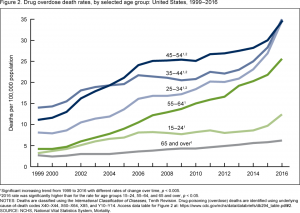On Thursday, the White House unveiled the first act in its effort to fight the opioid epidemic by harnessing the power of digital media and cable TV.
A partnership between the White House Office of National Drug Control Policy, the Truth Initiative, a nonprofit previously focused almost exclusively on efforts against the tobacco industry, and the Ad Council created and premiered “The Truth About Opioids” ad campaign. The project aims to “close the knowledge gap” about the dangers of opioids and “empower people with the truth” to help them fight and prevent addiction.
The campaign kicked off with an airing of the first spot early that morning on the Today Show.
Soon after, during a phone briefing, the President’s Counselor, Kellyanne Conway, delivered a carefully crafted speech, in which she reiterated that the Administration understands the multifaceted nature of the opioid crisis and that the campaign is only a part of an effort aimed at “preventing new misuse and new addiction by raising awareness.”
Spearheaded by the Truth Initiative, best known for its aggressive anti-tobacco campaigns, “The Truth About Opioids” will target primarily young people between 18 and 24 years of age, across all digital media platforms.
Four short documentary-style video clips tell the real cautionary tales of four young adults who harm themselves in violent ways in order to gain access to more opioids.
The shock value is there, and so is the production value. The videos provoke that unpleasant sensation one gets from well-executed, naturalistic depictions of pain.
Every spot provides a backstory, probably the most important element of the whole endeavor, trying to show that opioid addiction is not — necessarily — a typical, recreational drug addiction.
The ads point to the systemic issues of over-prescribing and lack of proper medical guidance that leaves young people addicted and desperate.
The campaign’s website provides a host of additional information with a clear goal of delivering easy to digest, basic knowledge on the issue. It’s hard to say just how successful these efforts will be.
We have written in the past about the potential pitfalls of following in footsteps of failed mass media campaigns, like the infamous Nancy Reagan initiative, “Just Say ‘No.’”
Robin Koval, CEO and President of the Truth Initiative, pushed back against that narrative. During the briefing, she pointed to extensive research conducted prior to the release, as well as Truth Initiative’s previous success in messaging to young adults.
Koval said that the Truth Initiative “tested over 150 different message possibilities, and pretested all of the advertising and the executions themselves.”
She also shared the criteria used to test the proposed messaging. “One, does it decrease intentions to misuse? […] Two, does it impact willingness to share with someone else? Does it increase risk perceptions? […] do these ads compel you to want to learn more — as we say, ‘Know the truth, spread the truth’ — and do they compel you to want to share them in your peer network? […]” According to Koval, the final ads were the most successful with the targeted age group.
Facebook, Google, YouTube, NBCU, Turner, Amazon, and VICE are among the companies that chose to donate their resources – broadcasting time, research, or online targeting tools – to help disseminate the campaign and reach the desired audiences. These are powerful allies for the cause.
Although the acting director of the ONDCP, Jim Carroll, didn’t put a price tag on the entire project, Lisa Sherman, President and CEO of the Ad Council, revealed that ONDCP “has funded a very small amount of money to support some of the other hard costs of the campaign.”
Carroll did answer other journalists’ question, saying that the campaign did not tap into the $10 million pot dedicated to fighting the opioid crisis that was secured in the Omnibus spending bill.
Koval added that “We [The Truth Initiative] felt very strongly that, because we had the ability to donate this, we want other funds to go to those very, very urgent matters of prevention, of rescue, of recovery, which are the things that are happening on the ground, right now, every day.”
While we can state fairly conclusively that “scare them straight” types of campaigns have historically worked poorly in reducing harm, these new educational efforts combined with relatable messaging could hold some promise.
The funding structure and emphasis on donated resources by some of the biggest tech corporations also holds promise.
For once, the powerful algorithms that seem to be driving so much of today’s online media traffic and economy are said to be targeting one of the nation’s biggest health problems.
Yet, no matter how optimistic the prospects of the campaign, we should remember that there remains a number of unanswered questions. To the people of Appalachia, some are more interesting than others.
How will the modern, 21st century online-based campaign overcome the connectivity problems across Appalachia? Is the knowledge gap the true problem in poverty-stricken communities, where the black market for the opioids serves as a source of supplemental income?
Last, but not least, when asked during the briefing about the choice of the age range of 18-24 as a target audience, Koval said that the choice was driven by Truth Initiative’s experience and pre-built trust among young adults. “We chose to focus on the group that we know […] It’s an audience that trusts us, that we have relevance with, credibility, and where we can create impact.”
That leaves large swaths of affected populations out of the campaign’s reach, often ones that — in sheer numbers — suffer the greatest loss of life due to the crisis.
According to CDC data, death rates due to drug overdoses are the highest among 35-44 and 44-54 age groups.
Here’s data accompanying the graph.
The promised scope of the campaign and the partnerships it managed to secure are impressive. Let’s hope the impact will be equally so.




